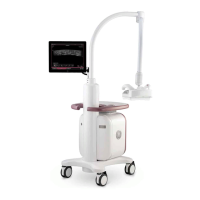Index-2 Invenia ABUS 2.0 – System Setup and Basic Service Manual
4700-0043-00 Rev. 4
what is EMC?, 1-22
EMI
abatement, 2-6, 7-33
prevention, 2-6, 7-33
protection, 3-34
recommendations, 7-32
environmental dangers, 2-18
error code identifications, 7-46
error code list, 7-48
errors, i-16
ESD prevention, 1-23
exam, 4-12
functional check, 4-13, 8-12
examine packages, 3-5
external I/O
connections, 3-42
F
facility needs, 2-7, 2-8
DICOM network function, 2-16
DICOM setup requirements, 2-17
facility needs, 2-8
important notices, 2-9
network setup requirements, 2-16
purchaser responsibilities, 2-7
flash card
connect, 3-43
functional checks
overview, 4-12
performance, 4-12
power on, 4-12, 8-7
probe, 4-12
shut down, 4-12
G
GE cares label, 3-36
general configuration
date and time, 3-63
general console requirements, 2-2
general procedures overview, 4-3
H
hardware problems, 7-36
heat problems, 7-35
hot or cold
if the unit is very cold or hot, 2-2
human safety, 1-13
I
icon description, 3-37
icons, 1-8
icons indicating a special procedure to be used, 1-11
if the unit is very cold or hot, 2-2
important conventions, 1-8
important notices
facility needs, 2-9
important precautions, i-2
indicator light, network, 3-70
installation card, 3-72
installation warnings
see "setup warnings", 3-2, 3-40
intermittent noise, 7-35
L
Label icon description, 3-37
label, GE cares, 3-36
labels
transportation box label, 3-6
labels locations, 1-12
legal notes, i-18
lighting, 2-2
list of abbrevations, 9-2
load
software, 8-14
Login, 3-46
lubrication
ball joint, 6-4
M
maintenance, 10-1
manpower needed, 8-3
manpower needed, 8-3
manual
service, 4-11
user, 4-11
manufacturer, 1-26
mechanical, 1-18
mechanical functions checks
scanner assembly, 4-14
mechanical safety, 1-18
models covered by this manual, 1-3
moving the system, 4-7
N
network
indicator, 3-70
network setup requirements, 2-16
noise picked up from the air, 7-34
noise troubleshooting
hardware problems, 7-36
heat problems, 7-35
intermittent noise, 7-35
noise picked up from the air, 7-34
recommendations, 7-34
self generated noise, 7-35
software problems, 7-36
types of noise, 7-34
O
omission and errors, i-16

